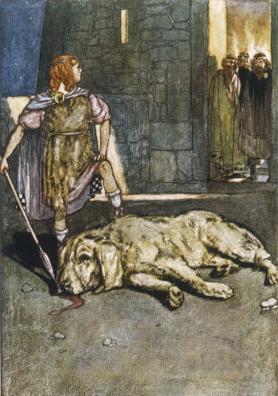The great mythic hero of Irish legend was Cu Chulainn (Pronounced "Coo-Cullen," no matter what the smarty pants linguists say). Cu Chulainn means "the Hound of Cullen." His given name was Setanta (which probably means "the pathfinder"). This passage from the Wikipedia article explains how he became "the Hound of Cullen":
Quote:The stories of Cú Chulainn's childhood are told in a flashback sequence in Táin Bó Cúailnge. As a small child, living in his parents' house on Muirthemne Plain, he begs to be allowed to join the boy-troop at Emain Macha. However, he sets off on his own, and when he arrives at Emain he runs onto the playing field without first asking for the boys' protection, being unaware of the custom. The boys take this as a challenge and attack him, but he has a ríastrad [a mythical ability of the warrior] and beats them single-handed. Conchobar puts a stop to the fight and clears up the misunderstanding, but no sooner has Sétanta put himself under the boys' protection than he chases after them, demanding they put themselves under his protection.
Culann the smith invites Conchobar to a feast at his house. Before going, Conchobar goes to the playing field to watch the boys play hurling. He is so impressed by Sétanta's performance that he asks him to join him at the feast. Sétanta has a game to finish, but promises to follow the king later. But Conchobar forgets, and Culann lets loose his ferocious hound to protect his house. When Sétanta arrives, the enormous hound attacks him, but he kills it in self-defence, in one version by smashing it against a standing stone, in another by driving a sliotar (hurling ball) down its throat with his hurley. Culann is devastated by the loss of his hound, so Sétanta promises he will rear him a replacement, and until it is old enough to do the job, he himself will guard Culann's house. The druid Cathbad announces that his name henceforth will be Cú Chulainn – "Culann's Hound".

That's not quite the version with which i am familiar, but Wikipedia provides a source which lists its sources.
Táin Bó Cúailnge (pronounced, roughly "chain voh Coolney," it means "Cooley's Cattle Raid") is the oldest, great mythic cyle of Irish legend which treats of men and their deeds, as opposed to the gods. The Men of Ulster had ridiculed and failed to show the requisite hospitality to a "witch," (who was actually the goddess Macha, in disguise and pregnant at the time) who cursed them with the wasting sickness at the time of their greatest need. The King and Queen of Connacht (the west of Ireland . . . Ulster is the north) had quarreled, and in their dispute, the Queen's bull, embarrassed to be owned by a woman, slips off and joins the King's herd. This leaves the Queen, Medb (pronounced, roughly, Maeve--it is often spelled that way), with less wealth than the King, Ailill, an important consideration in ancient Keltic society--a woman takes over the household if her wealth is greater than her husband's. Some warriors of Ulster, lead by Fergus, had gone into exile in Connacht, and into the service of Medb. Keeping the story short, Medb sends some messengers off to obtain the great bull of Cooley, and they get drunk and screw up the negotiations. So, Medb orders Fergus to invade Ulster and seize the bull. Against his better judgment, Fergus agrees, and as this is the time of their greatest need, the Men of Ulster fall ill, and cannot defend themselves.
But Setanta did not live with the King at the time of the curse, so he is the only one who can defend Ulster. The story is a long one, and Cu Chulainn (Setanta) fights duel after duel with Medb's heroes. Since he cannot defeat an entire army, he defends each ford by challenging the champions of Medb's army to single combat. Eventually, the Men of Ulster recover from their sickness and come to fight the invaders. Cu Chulainn is killed in the final battle, just seventeen years of age.
